If you are seeking relief from foot and ankle pain and you live in or near Edmonton, Alberta, the Unpain Clinic may be able to help you. We provide physiotherapy, shockwave therapy, chiropractic and massage therapy to help our patients get free from foot and ankle pain. We also believe it is important for our patients to be well informed and with that in mind, read on to learn more about foot and ankle pain.
Anatomy of the Foot and Ankle
The foot is made up of 26 bones including the phalanges (toe bones), metatarsals (forefoot bones) and the named tarsal bones which make up your mid-foot and heel. The tarsal bones include your calcaneus, talus , cuboid, navicular and cuneiform bones. Between these bone there are 33 joints in the foot and over 100 muscles, ligaments and tendons as well.
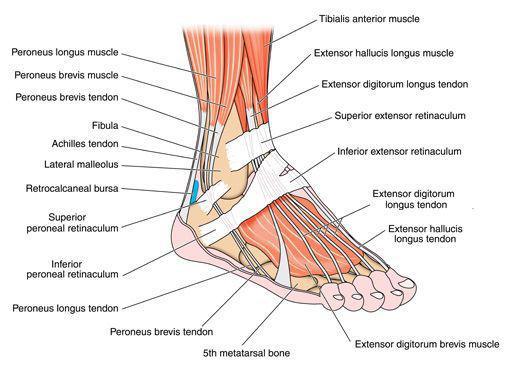
The ankle is a joint that includes the talus and the bones of the lower leg – the tibia and fibula. The ankle is stabilized passively by a number of ligaments and actively by the tendons of several muscles including the fibularis group, the achilles tendon and the flexor and extensor groups of the lower leg.
The foot and ankle are complex structures designed to form a base of support for your body that also allows for effective movement during weight-bearing activities. Due to their complexity the foot and ankle have many possible sources of pain and discomfort and treating them can range from simple to quite complex.
Causes of Foot Pain (and ankle pain)
There are two main causes of foot and ankle pain:
- Traumatic injury – a sudden event that can cause instant pain and dysfunction such as a torn muscle, strain or sprain, fracture, impact injury or blunt force trauma. These types of injuries usually require medical attention within minutes or days of onset.
- Non-traumatic processes– pain which seems to creep in over time and which may seem to the patient not to have an obvious cause or source. This type of pain may be related to:
- muscular dysfunction
- changes to the health of joint elements such as ligaments, cartilage or bone
- degenerative processes related to metabolic changes or aging
Common Conditions that lead to Foot & Ankle Pain
| Traumatic causes | fractures contusion or direct blow to the foot (e.g. dropping something on the foot, stubbing a toe, etc.)strain or sprain injury pulled muscle traumatic overuse injuries |
| Non-traumatic causes | GoutPlantar warts Plantar fasciitis Bunions Neuropathy – can be from a variety of causes, but diabetes is the most commonMorton’s neuroma Chronic overuse injury Achilles tendonopathy Corns and callouses Poorly fitting foot wear, wearing non-supportive footwear Ingrown toe nailsMetatarsalgiaReynauds disease Arthritis – osteoarthritis, psoriatic arthritis, rheumatoid arthritis, septic arthritisPaget’s disease BursitisTarsal tunnel syndromeTendonitis *This list is not exhaustive. See your medical professional for a diagnosis of your foot pain. |
Overuse syndromes of the foot and ankle
Many times foot pain has no obvious cause and in these cases, the issue could be that there has been an overuse injury. There are two kinds of overuse injuries, traumatic overuse and chronic overuse.
Traumatic overuse can occur if you perform an activity that you have not properly trained for, e.g. you run a marathon without training, switch from full support to barefoot shoes without a transition period or go from being sedentary to suddenly being on your feet for long periods at a time.
Chronic overuse comes on more slowly and is typically linked to spending long hours on your feet whether at work, at home or during exercise. This can be exacerbated by:
- wearing foot wear that is too tight or fits improperly
- wearing foot wear without adequate support –heels, ballet flats and men’s dress shoes are often bad for this
- wearing inadequate foot wear for the activity you are performing – shoe properties are optimized to the activity they are designed for, wearing a simple cross trainer for all types of exercise or activity is not appropriate
- wearing footwear improperly – incorrect lacing on shoes, not fastening zippers or buckles
- carrying extra weight on your body or in loads strapped to your body
If you feel overuse might be causing your foot pain, try activity modification and correcting your footwear first. When looking at footwear:
- Look for a shoe that is suited to your needs, or that is made specifically for your sport.
- Choose a shoe with appropriate room for your feet that does not make them feel cramped, jammed or pinched and that has plenty of room at the toe box so the toes aren’t squished together.
- Make sure your shoes are laced properly –you can find many tutorials online that cover different ways of lacing your shoes for various sports or to relieve discomfort in certain areas of the foot .
- Consider an over the counter insole (available at most pharmacies) to provide extra padding and comfort.
If these strategies fail, seek out a podiatrist, chiropractor or physiotherapist who can help diagnose and treat your pain and offer strategies to help you get back on your feet (pun intended) faster.
Is Foot & Ankle Pain Dangerous?
Not usually, but in some cases it can be. Ignoring pain is never a good thing, but ignoring pain in a weight-bearing area (like the foot or ankle) can take an extra toll on the body. Additionally, since the foot and ankle are the foundation for the body and how we move, long term dysfunction in these areas can create biomechanical alterations and dysfunction in the rest of the body.
Foot and ankle pain could be considered dangerous and should receive immediate medical attention if:
- If you have experienced a sudden traumatic injury, especially if it you heard a loud pop or snap at the time of injury
- If you cannot weight-bear on one or both feet
- If your foot or ankle is red, very warm, very swollen or if you have an obvious deformity
- If you have dramatic changes in your range of motion – e.g. you can’t move your foot, ankle or toes
- If you have pain with signs of an infection (fever, chills, redness)
- If you suddenly lose feeling or have new onset numbness in your feet
- If you have a wound or sore on your feet that is not healing or enlarging
Treatment for Foot Pain or Ankle Pain
The treatment for your pain depends on what is causing the pain. In some cases the solution may be as simple as good advice, activity modification or rest and at home pain relief strategies (using ice or heat packs, using a compression bandage or stocking or using a pain relief cream). In other cases you may need more specialized care which could include:
- Medication – prescribed or over the counter medications designed to treat your pain or the underlying condition causing your pain.
- Exercises
- Physiotherapy, chiropractic or podiatry
- Surgery – in some cases when pain is resistant to conservative care or is beyond the scope of allied healthcare providers, surgery may be necessary. Conditions that are more likely to require surgery include, bunions, Morton’s Neuroma, ingrown toe nails and non-healing diabetic ulcers of the foot. In cases of traumatic foot or ankle injury operative repair may be necessary to restore function and alignment of the foot.
How can a physiotherapist help relieve the pain in your foot & ankle?
Ankle and foot physiotherapy (or chiropractic) focuses first on identifying the cause of your foot pain and then on treating it. To get their patients feeling better, generally conservative healthcare providers use a combination of education and advice, rehab exercise, manual therapy (joint mobilization or manipulation, soft tissue therapy) and modalities like shockwave therapy, TENS therapy, ultrasound or laser.
Shockwave therapy for Foot Pain
At the Unpain Clinic one of our favorite treatments for foot and ankle pain is extracorporeal shockwave therapy, or simply, shockwave. Shockwave is a healing soundwave that is directed into the tissues to help relieve pain and promote local healing. There is reasonable evidence that shockwave therapy can[h1] be helpful for a number of conditions of the foot and ankle including plantar fasciitis and Achilles tendonopathy.
Exercises for foot pain and ankle pain
Gatrocs stretch
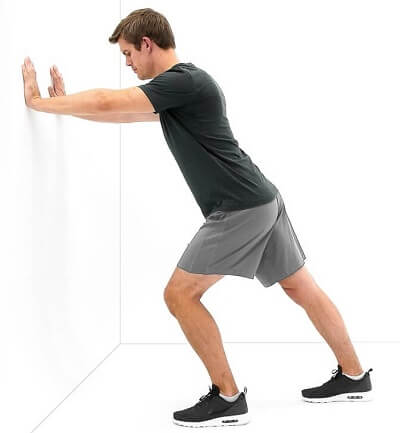
- Stand facing wall or counter with both hands on the support surface
- Take a good sized step forward with one leg and back with the other leg
- Keep your back hip and knee straight and bend the forward knee until you feel a good stretch in the back of your leg.
- Hold about 30 seconds on each leg
Ball release for foot
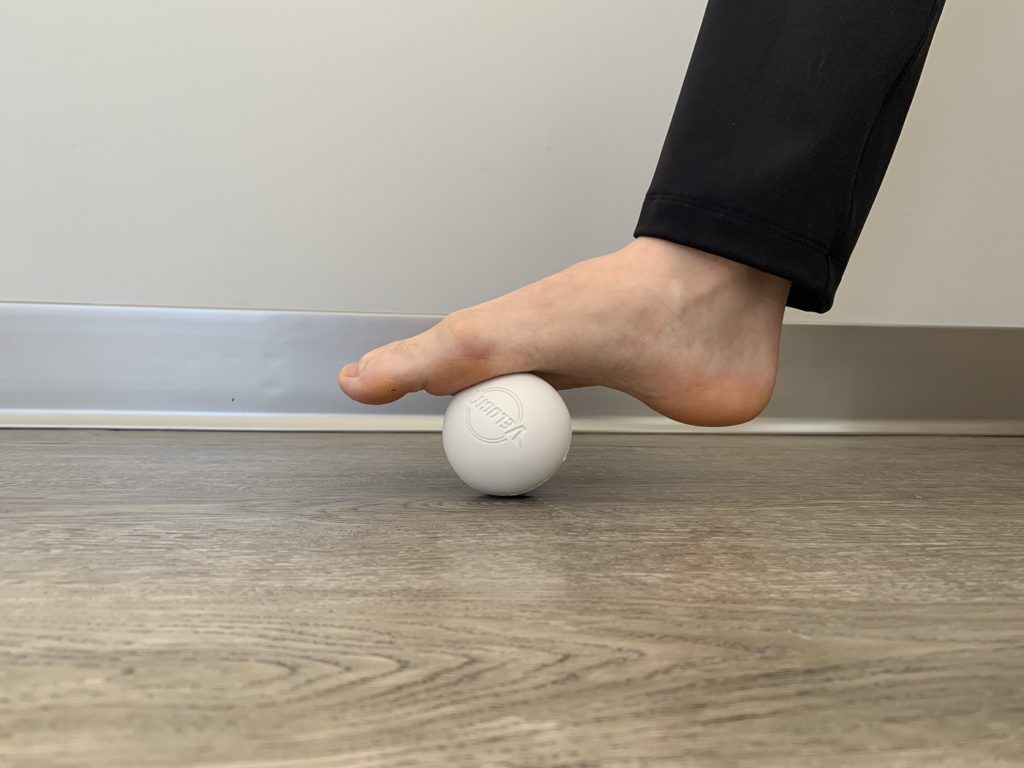
- Place a tennis ball under your foot and using firm pressure, roll the tennis ball back and forth
- When you find a sore spot, concentrate on that area
- Continue this for a few minutes or until your foot feels more relaxed and comfortable
Ankle circles
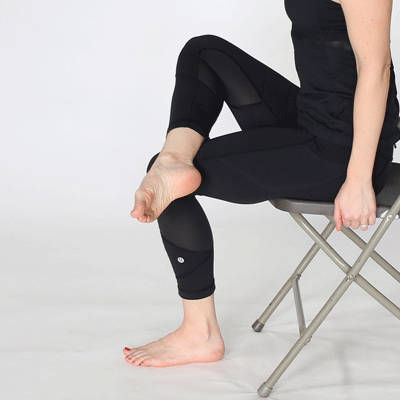
- Sit in a chair with good posture and the edge of one heel resting on the floor out in front of you
- Trace clockwise/counterclockwise circles with your big toe
- Continue this for a minute or two on each side
Towel scrunching
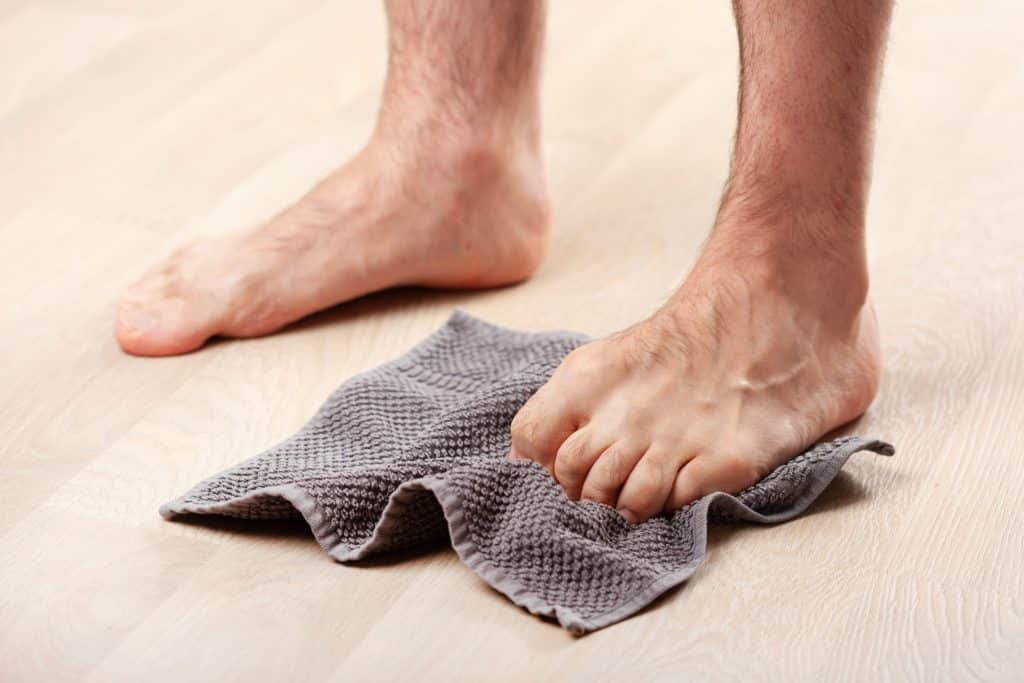
- Sit with your foot on a towel and use your toes to scrunch the towel toward you
- Work at this for up to one minute and switch feet
Ankle Pumps
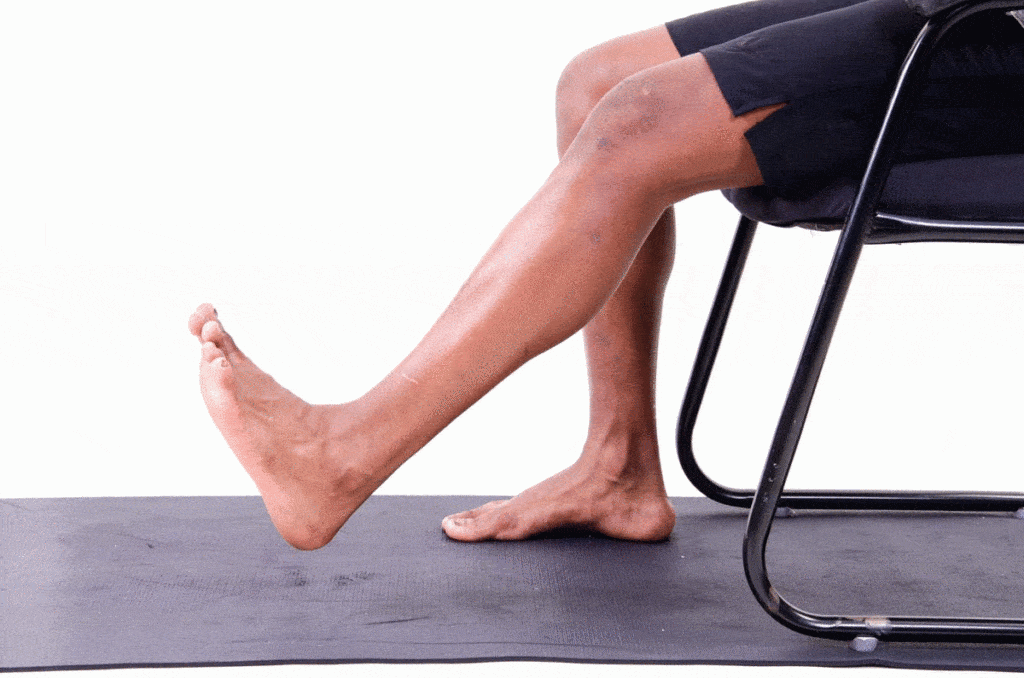
- Find a comfortable position with the legs extended
- Pump your ankles up and down as if you are pumping on a brake or gas pedal
- Continue for 10-20 reps
Tibialis Anterior stretch
- Stand next to a wall, with the foot you are stretching behind you
- Push the top of your foot down against the ground, straightening your ankle as much as you can at the same time
- Hold for 20-30 seconds and repeat on the opposite side
FAQs for Foot and Ankle
What is the most common foot pain?
There are several conditions which occur very commonly in the foot, including bunions, Morton’s Neuroma, peripheral neuropathy, gout and plantar warts, but the condition we see most at the Unpain Clinic is Plantar fasciitis.
Who do I go see if I have a foot problem?
You may think that only a podiatrist can help with foot pain, and while podiatrists are foot experts, many other practitioners are educated and trained in the treatment of foot pain. Your medical doctor, chiropractor or physical therapist also have the ability to assess your foot pain and create a plan of management to help you feel better.
If you have foot pain, be aware that you do not need a referral from a medical doctor to see a chiropractor, podiatrist or physical therapist, however you individual benefits plan may ask for a doctor’s note before they will cover the costs of some allied care providers.
Can a physical therapist help with foot pain?
Yes! At least it is a good place to start if you have foot pain. They are able to assess you and may be able to offer a number of therapeutic options to get you feeling better. If your foot pain is beyond the scope of what they can treat, your physical therapist can also refer you to an expert like a podiatrist or orthopedic surgeon.
What methods does Unpain Clinic use to treat Foot Pain?
At the Unpain Clinic we have a physiotherapist, chiropractor and numerous massage therapists who are a part of our healthcare team. Additionally our chiropractor, physiotherapist and clinic owner (massage therapist) are trained shockwave therapists. Each team member will use their unique education, training and skills to formulate a care plan that meets your needs.
Is a Physiotherapist covered by Alberta Health Care?
Yes and no. Confusing, right? Alberta Health Care holds contracts with specific clinics – so you could have a perfectly good physiotherapist in a private practice who is not covered under Alberta Health Care since they do not negotiate contracts with them. It usually comes down to cost. If a clinic is offering a more specialized service that is more expensive to offer, it is not typically covered by Alberta Health. There are, however, many reputable clinics out there that provide excellent traditional care for clients under Alberta Health Care contracts. Unpain Clinic does NOT bill to Alberta Health Care at this time.
How much does physiotherapy cost in Edmonton, Alberta?
Physiotherapy in Edmonton can range anywhere from $50-$400+ per visit. The price depends on the therapist, the clinic, and the technology or treatment being offered.
Do you need a referral to see a physiotherapist in Edmonton, Alberta?
No. Physiotherapists are considered primary healthcare providers, along with medical doctors, chiropractors, naturopathic doctors and acupuncturists. These professionals do not require a referral from a medical doctor for you to see them. Be aware that your extended health benefits plan may require a doctor’s prescription in order for you to claim your visit. The best way for you to know if you need a referral is to call your benefits provider or check out their website.
Here at Unpain Clinic we always accept and appreciate referrals from medical doctors and other healthcare providers and are happy to collaborate and communicate with them to ensure you get the best care possible.
Still have questions?
Book a free no obligation consult with one of our team members to find out more about shockwave and other therapies offered in our clinic.
True Shockwave™ or Flashwave®? No need to wonder.
Our therapists will assess your situation and formulate a True Shockwave™, Radial Pressure Wave or Flashwave® treatment plan appropriate for achieving the most effective and lasting results.